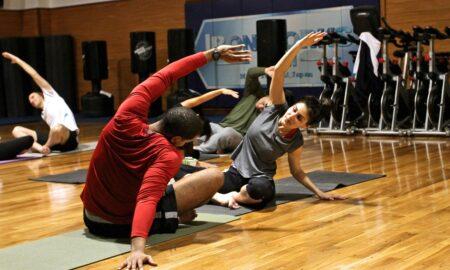One of the most frequent questions I get deals with coming back to strength training after a layoff. It’s a common concern because a great many people aren’t sure how to approach it, and so they run into difficulty. In nearly every instance lifters try to get back to their former strength levels too rapidly, and they either become overtrained or end up with some sort of injury.
Everyone takes some time off from training at some point and for a variety of reasons. Vacations head the list, followed by injuries or medical conditions. Family emergencies, such as a sick child or a death, can lead to layoffs, as can the times when people know they’re severely overtrained and need to take some time off.
Regardless of your reason for missing training for a couple of weeks or more, it’s useful to understand a few things about what goes on with your body during such rest periods. It changes when it’s not active, and you have to take those changes into consideration when setting up your comeback routine. The most important change is the sad fact that strength diminishes at an alarming rate. It would be nice if a long period of hard training was like putting money in the bank. Then you could draw from the reserve during a layoff. It doesn’t work like that, however.
How much strength is lost varies from individual to individual, but on average it can drop as much as 40 percent after just two weeks. Not only do the top-end numbers plummet like a rock, but the overall level of conditioning declines as well. So, when you start back, you’re much weaker and not able to train with any real intensity for as long as you could before. The recovery process is much slower, and soreness lingers.
In many ways your physical state when you resume training is very similar to what it was when you first started. The major difference is that you now have a much better understanding of what you’re getting into and you also know how to perform the exercises correctly. Even so, those factors are often negatives when you’re starting back on a routine.
For one thing you can dive into your program at a faster pace than you did the first time. What’s more, if you’d previously moved many of your lifts to a high level, relatively speaking, you’re going to be extremely anxious to get back to those numbers as soon as possible. For example, someone who spent the better part of a year pushing his bench press to 365 is going to be frustrated that he can only manage 305 when he comes back to the gym. He simply won’t be able to stand that, so he’ll charge into his bench routine like a madman, doing too much too soon. He’ll overtrain, but he’ll be determined. Finally, a nagging pain in his shoulder will force him to stop benching for another few weeks, and his 305 will drop to 290.
Your time away from the weights can be very useful if you plan your comeback properly. On the other hand, it can cause long-term hardship. As with everything else in strength training, I learned that lesson the hard way. Whenever I returned to the gym after a layoff of any length, I tried to regain my former level as quickly as possible. It just didn’t work out that way. I always had to back off and, basically, start from scratch.
I learned the most from watching some of my fellow lifters deal with the situation. The first to open my eyes was a teammate on the Dallas YMCA weightlifting squad. He’d been away from training for almost six months. (I’ll omit his name, since those six months were spent in jail.) He’d been one of our strongest lifters, but at his first workout after coming back, he only did three sets of five on three exercises: squats, power cleans and presses off the rack. He used 135 on every set.
What a complete waste of time, I thought. We trained together three days a week. At each workout he did a bit more’an extra set here, a back-off set there’and he steadily moved his numbers up. Within six weeks he’d passed me.
When I was working at the York Barbell Company, I watched Jerry Ferrelli do the same thing. He started back after a full year’s layoff. At his first session he did three sets of five on the squat, only going to 225’nothing to brag about at the YBC. Six weeks later he won the Middle Atlantics and smashed several meet records.
Both of those athletes were a cut above the norm, but the lesson stuck with me, that lesson being that when you start back on a routine, less is better than more. I have to deal with the situation constantly because my athletes do very little in terms of serious strength work in season. Most of them simply don’t have enough time or energy. The baseball team may play six games in a week, the lacrosse team three and the basketball team three. It’s the same with the women’s lacrosse and field hockey teams. The football players do the most strength work in season’but not across the board. Some never touch a weight. At Hopkins, as with many schools, books take precedence over weights.
So, when they come in to start their off-season programs, I have to organize their routines with the idea that they’re starting back after an extended layoff.
It can be a very useful period if you set it up properly. The layoff offers many benefits. It gives sore or injured areas the time to heal. For some odd reason I’ve never been able to explain, bad technique habits often vanish. I’ve had athletes who simply could not master the form on the power clean, but following a layoff they walked up to the bar and did the exercise properly.
The period after a layoff is an ideal time to change your routine. Altering the exercises forces you to use less weight while you learn correct form. That’s a good thing because it keeps you from increasing your numbers too rapidly. The revised routine should be aimed at strengthening weaker areas rather than doing more for the stronger ones or inserting new ones you’ve been wanting to do for some time, such as the power snatch or full clean.
It’s also the perfect time to learn a new lift, especially if you’re more advanced and have a firm background in training heavy. With a fresh, rested body you can learn new movements more readily, and you can learn a great deal about which specific muscles an exercise hits.
I picked up that notion from Tommy Kono, who told me that whenever he inserted a new exercise into his routine, he’d intentionally overwork it. The next day he could identify the individual muscles that had been exercised. I tried his trick, and it worked wonderfully. It’s very useful for serious strength athletes because you can store the information and use it at a later date.
The idea of overtraining a new exercise when you’re starting back on a routine is the exception to the rule about overtraining. Generally speaking, a conservative approach is in order. As I said, less is better. When it comes to legs, that means a lot less. The back and shoulder girdle can handle more than the legs; that is, if you’re working your legs with full squats. Squats are the most demanding of all movements, and lifters, especially advanced lifters, tend to forget that simple fact when they start back. Regardless of a person’s previous best, I have all my athletes stop after three sets, with the final set being relatively light. I do that even if they’ve only missed two weeks in the gym. Naturally, there are arguments. ‘I don’t feel as if I did anything,’ ‘I’m not tired,’ and ‘I can do more,’ are among the most common.
When they come in two days later, they thank me. Some confess that they had trouble walking up steps the day after they squatted. Even though I’m a major advocate of getting people sore, I don’t want them to be sore to the touch in the early stages. It increases their risk of pulling a weaker muscle.
In most cases I allow them to do a bit more on their back and shoulder exercises’usually four sets of five on the power clean and bench. They do no back-off sets for any exercises and no auxiliary work during the first week back after a layoff.
At the second workout I have them do four sets of squats, usually ending up with the same top-end weight they used at the first workout. They can also add a fifth set to their pulls and benches.
The third workout of the week is key. The lifters have gotten rid of their soreness and are usually full of vigor, ready to lift something heavy; however, they need to remain cautious. I have them do five sets of squats, and they can increase the final set to more weight than they used on Monday and Wednesday, but not by too much. They do five sets on back and shoulder girdle movements as well and, again, move up the last set. They still do no auxiliary work or back-off sets, only core exercises. Some lifters who have decided to attack a certain area, typically the chest and arms, ignore the other groups and concentrate all their early efforts on upper-body exercises; however, that’s not the right approach. Reestablish a solid strength base from foot to neck first, then move on to a more specialized routine. If people can discipline themselves to remain conservative during their first week back, the odds are in their favor that they’ll flow back into their routine easily.
By the second week most lifters can resume a full workout and start adding back-off sets and one or two auxiliary exercises per session. The rate of progression varies from person to person. Some of my more experienced athletes can be back carrying a full load by the third week. Rookies often take a month or more. It doesn’t matter how long it takes. The important point is to build a solid foundation first and make steady improvement. It’s been my observation that slow gainers usually end up ahead of fast gainers.
For the first couple of weeks stick with training three days a week. After that you can add another day if you choose. That helps you avoid overtraining. While it’s a fact that many are blessed with a natural ability to retain a higher level of strength than the norm, no one can override the fitness factor. It just takes time to reestablish the ability to train hard and recover sufficiently to train hard at the next workout. There’s no way to hurry the process.
Everyone who’s started back after a layoff knows that one area of his or her body retains strength much better than the other two. For most that stronger area is the back. Some find that they can handle close to their very best on all their back exercises in that first week back at the gym. Again, caution should be a key word. Even though they have maintained strength, there may be some smaller muscle groups that are involved in the exercises that aren’t ready for the load just yet. Good mornings are a prime example. Many can handle their best numbers on good mornings during the first week if they choose, but if they do, they get sore to the touch, and that’s not good. Being that sore in an important area such as the lumbars leaves them susceptible to getting hurt, most likely on an exercise that uses the lumbars directly, such as squats or shrugs.
Yet another point in favor of the cautious approach is that many or all of the other factors that are critical to success in the weight room are neglected during a layoff. Your sleeping and eating habits typically deteriorate, especially if you’re on vacation. There’s less need for sleep, and that quickly develops into a habit. The tendency is to eat more than usual, and the kinds of foods you gobble down on a road trip aren’t as nutritious as what you eat when you’re at home with training on your mind. You consume more alcohol and probably leave your nutritional supplements behind, or, if you do bring them, take them sporadically.
That means, when you go back to the gym, your body isn’t as prepared for the hard work as it was before the layoff. Again, moving slowly allows your system to gear back up, something it cannot do instantly. You have to reestablish those important disciplines, diet and rest, before your lifts can climb once more.
Due to the rest period, there’s always a surge of energy when you return to training. Nevertheless, it’s not smart to charge into a routine. Starting back after a layoff is similar to beginning a strength-training program. In both cases the program must include patience and a dose of common sense, with the underlying message that you should make haste slowly. If you use the prudent approach, especially during that first critical week back, you’ll greatly aid your quest to move to a higher level of strength fitness. IM




















You must be logged in to post a comment Login